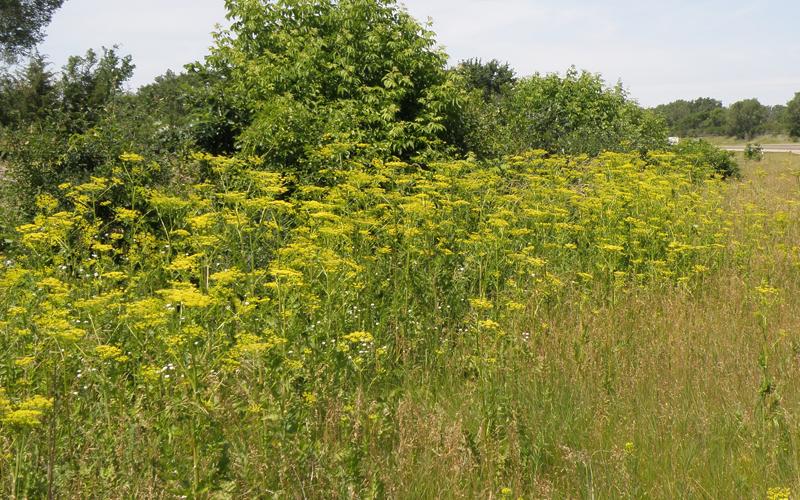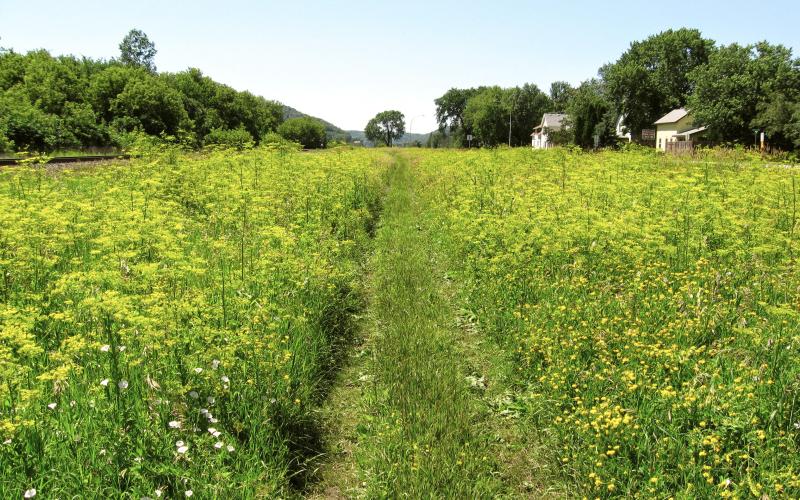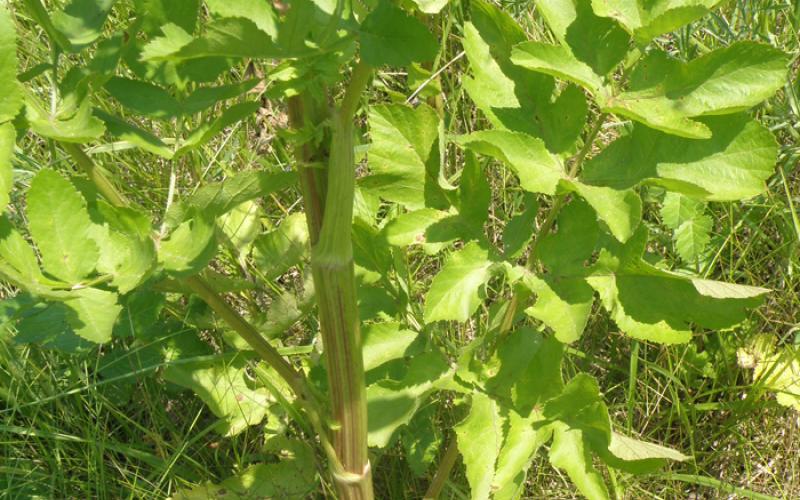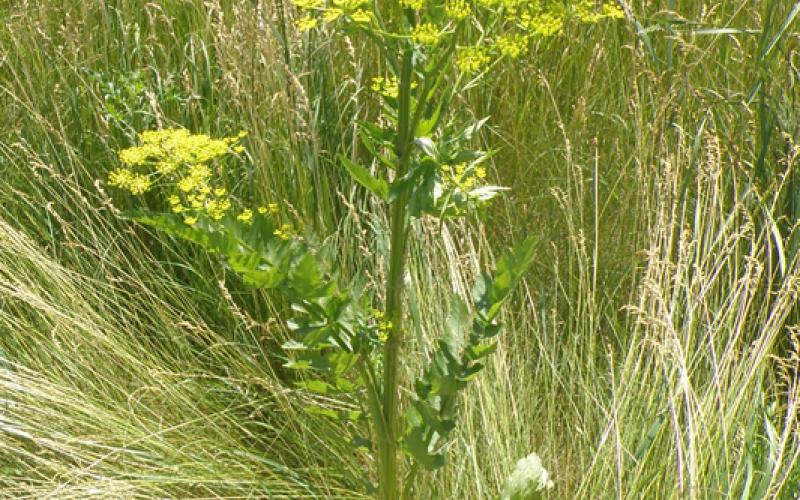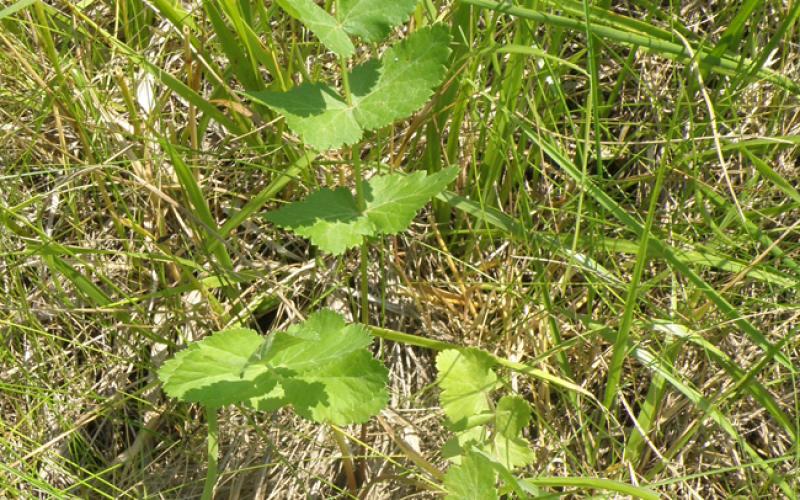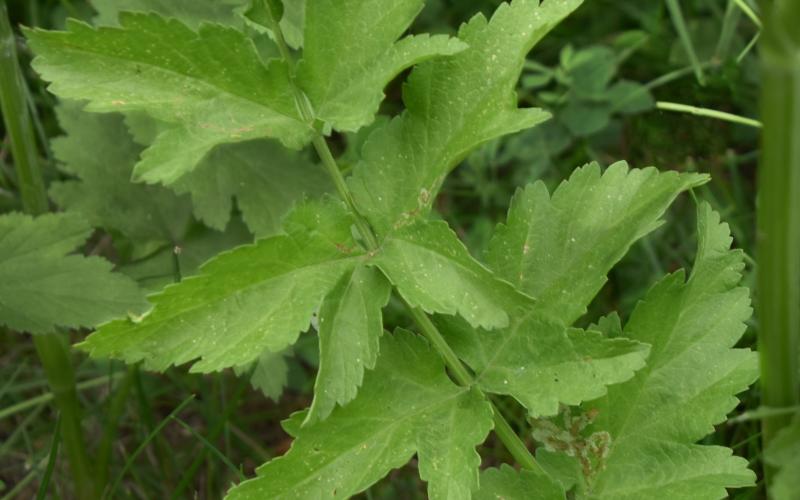Common Name: Wild Parsnip
Scientific Name: Pastinaca sativa L.
Legal Status
Efforts must be made to prevent seed maturation and dispersal of plants into new areas. Additionally, no transportation, propagation, or sale of these plants is allowed. Failure to comply may result in enforcement action by the county or local municipality.
Background
Wild parsnip is native to Europe and Asia. It was brought to North America by European settlers and grown as a root vegetable. Over time, it escaped from cultivation, and is now common throughout the US.
Description
- An aggressive, monocarpic perennial plant that germinates from seed, spends the first year or more as a rosette, eventually bolts into a mature plant in the second year or later, flowers, sets seed, and dies.
- Grows 4- 6 feet tall.
- Leaves alternate along the stem, are pinnately compound, and consist of egg-shaped leaflets having saw-toothed edges that are arranged in pairs along the stalk; becoming progressively smaller near the top of the stem.
- Bolted stems are erect, branched, hollow, slightly grooved, and terminate in flat-topped, compound flower umbels. Umbels are generally 2- 6 inches wide and contain many small, 5- petaled yellow flowers that bloom from June through late August.
- Reproduces by seed. Seeds are small, broad, oval, slightly ribbed, and are produced in the umbels several weeks after flowering. The plant dies after setting seed.
- Forms a long thick taproot that is similar in appearance and smell to cultivated parsnips.
Habitat
Wild parsnip is most commonly found along road and rail rights-of-way. It is also found invading a variety of disturbed landscapes including trails, natural areas, pastures, forest and field margins, waste areas, unmaintained gravel pits, and idle lands. It can tolerate dry, mesic, or wet soils, but does not grow in shaded areas.
Means of spread and distribution
This plant spreads primarily seeds. Seeds remain viable in the soil for several years. It is found commonly throughout Minnesota, with the highest populations in the southeastern region.
Impact
Wild parsnip is highly invasive and if ignored can spread rapidly, developing into large monocultures that replace native animal and plant habitat. It reduces the quality of agricultural forage crops and can negatively impact livestock if ingested. The plant sap contains toxic chemicals that are activated by sunlight and can cause serious burns and blisters to human skin after contact.
Prevention and management
- A sound management plan is necessary to manage this species and will take several years of commitment to ensure that the population has decreased significantly and is not a serious problem. Management plans that combine fall and early spring applications of specific foliar herbicides and pre-flower mowing throughout the growing season have been shown to produce excellent results, especially when follow-up management occurs for several years until the seed bank is significantly reduced. Restoration of treated sites by fostering existing or newly planted site-specific native plant species can also sustain management well into the future and prevent new populations from developing. When working in or around wild parsnip, ALWAYS wear proper clothing and gloves that protect the skin from contact with the toxic plant sap of this plant.
- Hand pulling is not recommended as the sap is toxic to human skin. Small numbers of plants can be removed by hand if using gloves and clothing to protect the skin from sap exposure. Rosettes and recently bolted stems (prior to seed-set) may also be killed by using a sharp spade or shovel to sever the tap root 1- 2 inches below the soil surface. Check sites periodically to remove re-sprouts and recently germinated seedlings and rosettes.
- Mowing or cutting stands larger stands prior to flowering in June will kill a majority of mature plants and significantly reduce seed production. Repeated mowing throughout the season and for several subsequent years is required to prevent re-sprouting and to cut newly bolted plants. After mowing an infestation, wash equipment in order to prevent the movement of seed into new areas.
- Use a selective broadleaf herbicide in the early spring or late fall to target rosettes and newly bolted plants prior to flowering. Several years of treatment may be required to control the overall population until the seedbank is exhausted or other vegetation begins to compete with the remaining plants. When considering the use of chemical treatment, check with your local University of Minnesota Extension agent, co-op, or certified landscape care expert for assistance and recommendations. There are also businesses throughout the state with certified herbicide applicators that can be hired to perform chemical applications.
- Wild parsnip lifecycle and treatment timing graphic
Toxicity
Wild parsnip causes phytophotodermatitis-- when skin comes in contact with plant sap in the presence of sunlight, it can cause severe rashes, blisters, and discoloration of skin. Appropriate protective clothing including gloves, long sleeves, and long pants should be worn and direct contact with the plant should be avoided. If sap comes in contact with skin, avoid exposure to sunlight, immediately wash skin with soap and water, and seek medical attention.
